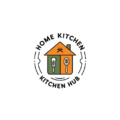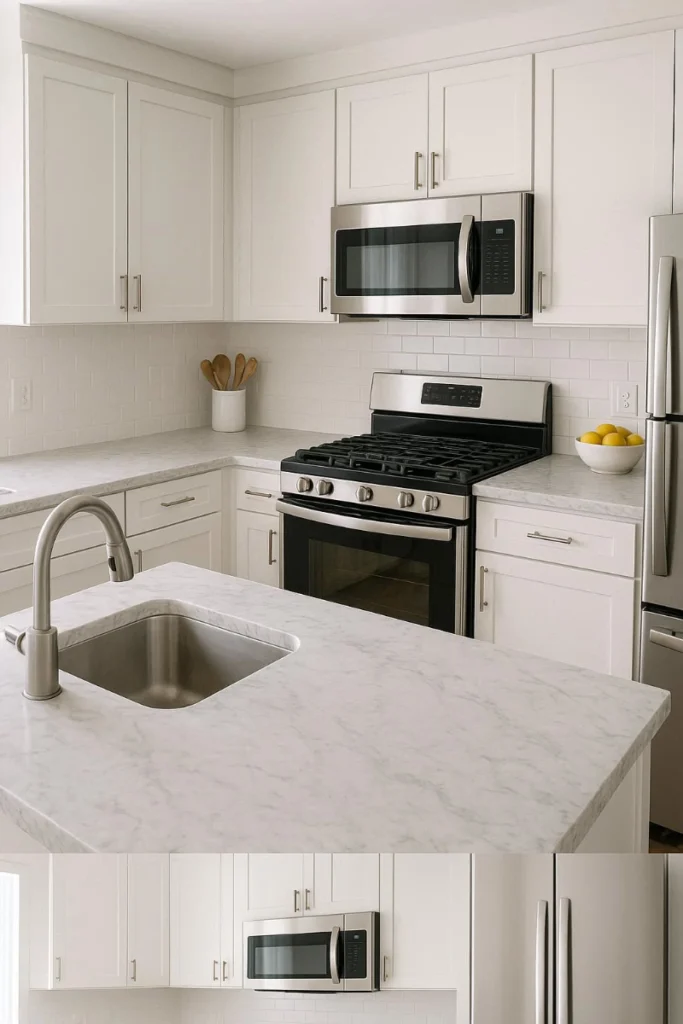When it comes to home design, your kitchen countertops are one of the most crucial elements. Not only do they serve a functional purpose, but they also play a huge role in setting the aesthetic tone of the room. Whether you’re preparing meals, entertaining guests, or just sipping coffee in the morning, your countertops are always in the spotlight.
But what if your kitchen countertops are outdated or damaged, but you don’t have the budget to replace them? Well, here’s an exciting solution: painting your kitchen countertops!
This DIY-friendly project has become a popular way to refresh and transform kitchen spaces without breaking the bank. Not only is it budget-friendly, but it also allows you to customize your countertops to fit your style. In this blog post, we’ll walk you through everything you need to know about painting kitchen countertops. From the feasibility of painting them to a step-by-step guide, we’ll cover it all.
Ready to give your kitchen a fresh new look? Let’s dive into the world of painted countertops!
Can You Paint Kitchen Countertops?
The Possibility of Painting Countertops
The first question most homeowners ask is: Can I really paint my kitchen countertops? The short answer is yes! In fact, painting your kitchen countertops can be a highly effective and cost-efficient way to revitalize your Ideas for Kitchen and Living Room space.
However, not all countertops are created equal. Some materials are better suited for painting than others. For example:
- Wooden countertops: These are among the easiest to paint, offering a smooth surface that holds paint well.
- Laminate countertops: These are also popular for painting since the smooth surface allows for easy adhesion.
- Granite or marble countertops: While it is possible to paint these, it’s more complicated, and the results may not be as durable. Special epoxy paints are required for these surfaces.
If you’re considering other options, consider refinishing your countertops with a new surface layer or even replacing them entirely. But if you’re looking for a quick, budget-friendly solution, painting might be just what you need.
Pros and Cons of Painting Your Countertops
Before jumping into the painting process, it’s important to weigh the pros and cons.
Pros:
- Budget-friendly: Instead of spending hundreds or even thousands on new countertops, you can achieve a similar look for a fraction of the cost.
- Quick transformation: With some time and effort, you can go from dated countertops to fresh, new surfaces within a weekend.
- Customizable: You can choose any color, pattern, or finish to match your kitchen’s style. Whether you prefer sleek modern black or a warm rustic wood look, the possibilities are endless.
Cons:
- Durability concerns: While painted countertops can look great, they are more prone to scratching, staining, and chipping, especially in high-use areas.
- Maintenance: Once your countertops are painted, you’ll need to take extra care to preserve their appearance. This may include avoiding harsh cleaning chemicals and using cutting boards to protect the surface.
- Not for every countertop type: If you have high-end materials like marble or natural stone, painting may not be the best option. These materials are better suited for refinishing or replacing.
How to Paint Kitchen Countertops: A Step-by-Step Guide
Now that we know it’s possible to paint kitchen countertops, let’s get into the details. Here’s a step-by-step guide to help you through the process.
Step 1 – Clean and Prep the Surface
Proper prep work is crucial to achieving a flawless finish, and this starts with cleaning the countertop thoroughly. Grease, dirt, and oils can prevent the paint from adhering properly, so make sure the surface is spotless.
- Clean thoroughly: Use a degreaser or a mix of warm water and dish soap to scrub your countertops clean.
- Sanding: Once your countertops are clean, sand them down lightly to roughen the surface. This helps the paint stick better. Use a fine-grit sandpaper and sand in circular motions.
- Protect surrounding areas: To avoid making a mess, use painter’s tape and drop cloths to protect the edges of your countertops and the surrounding areas from paint splatters.
Step 2 – Choose the Right Paint and Materials
Choosing the right paint is essential for achieving long-lasting results. Here are some options:
- Epoxy paint: This is the most durable choice for kitchen countertops, especially when working with laminate surfaces. It forms a hard, glossy finish that resists stains and scratches.
- Oil-based paint: Ideal for wood countertops, oil-based paints provide a smooth finish and excellent coverage.
- Chalk paint: A great option for achieving a matte, vintage look, chalk paint works well on wood or laminate surfaces. However, it’s not as durable as epoxy or oil-based paints.
Additionally, you’ll need some essential tools:
- Paintbrushes: Choose a brush that’s appropriate for the paint you’re using. Foam brushes work well for smooth finishes.
- Rollers: Use a small roller for large, flat surfaces.
- Paint trays: For easy paint application.
- Sealant: A clear coat of polyurethane or epoxy will protect the painted surface and give it a professional finish.
Step 3 – Apply the Paint
Once you’ve prepared the surface and gathered your materials, it’s time to start painting.
- First coat: Use a paintbrush to apply the first coat of paint, starting at the edges and working your way toward the center. Make sure to apply thin, even coats to avoid drips and streaks.
- Drying time: Allow the paint to dry fully before applying additional coats. Most paints require at least 4-6 hours to dry between coats.
- Additional coats: Apply 2-3 coats for full coverage, ensuring that each coat is dry before adding the next.
Step 4 – Seal and Cure the Surface
Once you’ve applied the paint and it’s dry, you’ll need to seal your countertops to protect them from damage.
- Sealing: Use a polyurethane or epoxy sealant to provide a strong, protective layer over your painted countertops. This will help prevent stains and scratches.
- Curing time: Allow the sealant to cure fully before using your countertops. This may take up to 48 hours, depending on the product.
Tips for Maintaining Your Painted Kitchen Countertops
After investing time and effort into painting your countertops, you’ll want to keep them looking fresh. Here are some tips:
Cleaning and Care Tips
To clean your painted countertops without damaging the surface, use mild cleaning solutions. Avoid abrasive cleaners that can scratch the paint. Instead, opt for gentle dish soap or a vinegar-water solution.
- Clean spills quickly: Wipe up spills immediately to prevent stains from setting in.
- Soft cloths: Use a soft cloth or sponge when cleaning to avoid scratching the surface.
How to Avoid Scratches and Damage
While painted countertops are more prone to scratches, there are steps you can take to minimize wear:
- Use cutting boards: Always use a cutting board to protect the surface from knife marks.
- Trivets for hot items: Avoid placing hot pans or pots directly on the countertop. Use trivets or hot pads to protect the painted finish.
Alternatives to Painting Kitchen Countertops
If painting isn’t the best option for your kitchen, you have other alternatives to consider.
Refinishing vs. Painting
If your countertops are scratched or worn, refinishing them may be a better option than painting. Refinishing involves sanding the countertop and applying a new coating, which can help restore the original look without the added maintenance of painted surfaces.
Replacing vs. Painting
While painting is a great temporary fix, replacing your countertops may be the better long-term solution if you’re after durability and high-end aesthetics. Replacing countertops ensures that you’ll get a fresh, high-quality surface that lasts for years without requiring constant maintenance.
Frequently Asked Questions (FAQs)
Can I paint granite or marble countertops?
- While you can technically paint granite and marble countertops, it’s not always the best option. These materials are porous and challenging to paint. It’s better to opt for refinishing or replacing them if you’re looking for long-term durability.
How long does painted kitchen countertop last?
- With proper care, painted countertops can last 3-5 years. However, they may show signs of wear and tear, especially in high-traffic areas.
Is it safe to paint kitchen countertops myself?
- Yes, it’s safe to paint your countertops yourself, but you should take proper precautions. Ensure proper ventilation, wear protective gear, and follow the instructions on the paint and sealant labels.
What’s the best paint for kitchen countertops?
- Epoxy paint is generally the best option for kitchen countertops because it’s durable, long-lasting, and resistant to stains and scratches. Oil-based and chalk paints are alternatives for wood and laminate countertops.
Can I use my kitchen countertops right after painting?
- No, you should allow the painted surface to cure for at least 24-48 hours before using your countertops to avoid damaging the finish.
How much does it cost to paint kitchen countertops?
- On average, the cost to paint kitchen countertops ranges from $100 to $300, depending on the size of your countertops and the materials you choose. This is much more affordable than replacing countertops, which can cost thousands of dollars.
Conclusion
Painting your kitchen countertops is an excellent way to give your space a fresh look without spending a fortune. With the right preparation, materials, and care, you can achieve a durable, stylish finish that transforms your kitchen. Whether you’re working with wood, laminate, or granite, there’s a painting solution for every countertop type.
So, are you ready to take on this DIY project and transform your kitchen? Don’t forget to share your experiences or ask any questions in the comments below!

